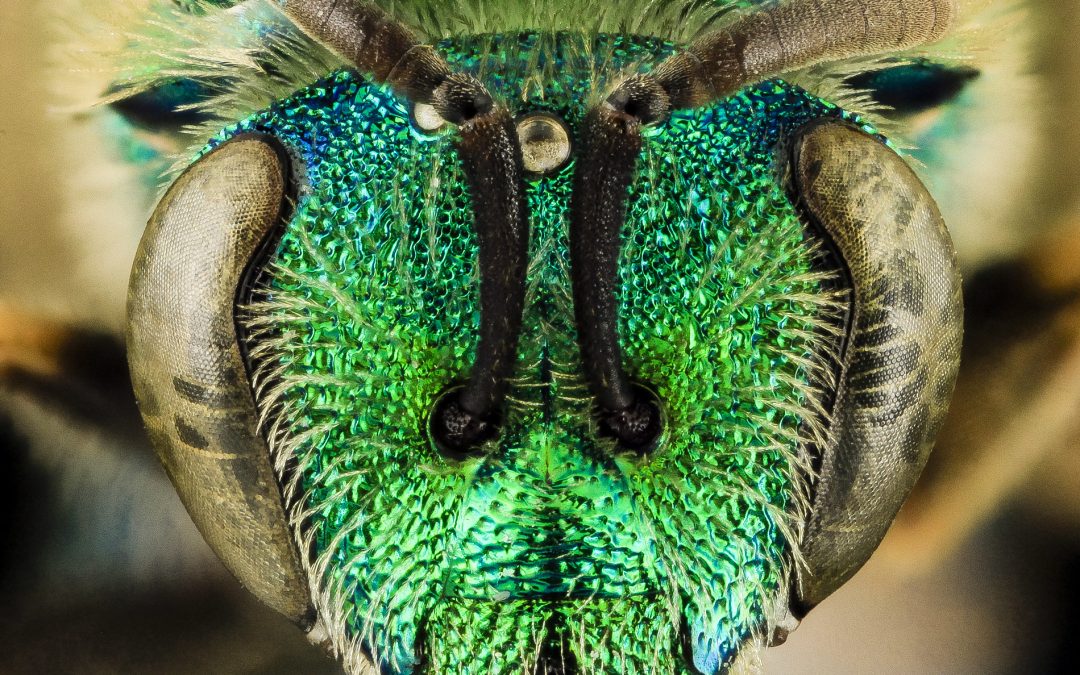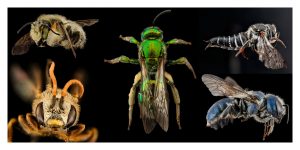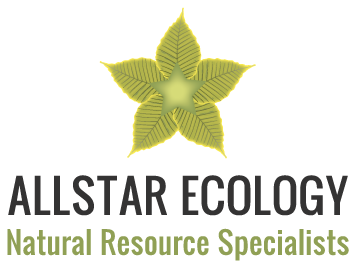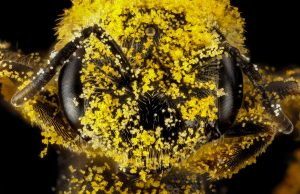
Pollinator Conservation: West Virginia’s Native Bees
Native Bees are Important to West Virginia
West Virginia’s native bees including bumble bees, mason bees, leaf-cutter bees, miner bees, and sweat bees are important to the pollination of most flowering trees, shrubs, and herbaceous plants within the forests and fields of the Mountain State. Therefore, our native bees are important mechanisms for feeding West Virginia’s people and wildlife. West Virginia is rich with a diversity of habitats such as large river valleys, high-elevation mountains, forests, fields, etc. that are home to a diversity of flowering plants that provide pollen and nectar for a diversity of native bees. There has been a rapid decline of bumble bee species (Bombus spp.) throughout much of North America, including some that were once common in West Virginia. This has created the need for inventories to determine the current status of all native bee species. The use of published bee research, museum specimens, and historical records coupled with field data is needed to develop a list and determine the status of West Virginia’s native bees.
 Top left: Megachile latimanus; Bottom left: Halictus ligatus; Center: Augochloropsis metallic; Top right: Coelioxys sayi; Bottom Right: Osmia texana
Top left: Megachile latimanus; Bottom left: Halictus ligatus; Center: Augochloropsis metallic; Top right: Coelioxys sayi; Bottom Right: Osmia texana
Surveying West Virginia’s Native Bees
In 2018, AllStar Ecology began coordinating with the U.S. Fish and Wildlife Service (USFWS), West Virginia Division of Natural Resources (WVDNR) and U.S. Geological Survey (USGS) to document West Virginia’s native bees. The WVDNR, the U.S. Department of Agriculture’s Forest Service (USFS), West Virginia State Parks, and private landowners granted permission for AllStar Ecology personnel to survey native bees on lands under their ownership and management. Four AllStar Ecology Environmental Scientists conducted 242 native bee surveys using hand nets within 45 of the 55 West Virginia counties that resulted in the collection of 6,377 bees. These surveys identified 124 species including a new location of the rusty-patched bumble bee (Bombus affinis), which is currently on the USFWS’s Endangered Species List (List). The male was discovered in Tucker County and with a rare color pattern. The yellow-banded bumble bee (Bombus terricola), a candidate species to be placed on the List was found at eight locations, representing the first records of this species in West Virginia since 1979. Also found were 16 species of specialist bees, which are species that only collect pollen and nectar from a specific plant species or plant group. Four species of the located specialist bees are considered to be rare. Three species that were not previously recorded in West Virginia were discovered, including a cuckoo bee (Nomada graenicheri), leaf-cutter bee (Heriades leaviti), and mining bee (Andrena illinoiensis) in Ritchie, Mingo, and Lewis Counties, respectively. This initial data is useful in determining which bee species are common and help to determine the distributions of rare, threatened, and endangered bee species. Future surveys will likely discover new species records for the state and additional locations of rare, threatened, and endangered native bee species. Click here to view the 2018 rusty-patched bumble bee collected in Tucker County, WV along with other WV native bees on the USGS Native Bee Monitoring and Inventory Lab’s Flickr page.
 Bombus affinis Bombus terricola Heriades leavitti
Bombus affinis Bombus terricola Heriades leavitti
West Virginia, a Mountain Refuge
The rusty-patched bumble bee found in 2018 is the second to be documented within West Virginia since the 1990’s. This is encouraging that there are additional areas where the species is finding refuge within the Mountain State. The West Virginia locations, along with locations found in western Virginia over the last few years, are the only locations where the rusty-patched bumble bee is being found east of Illinois. The USFWS has a rusty-patched bumble bee map that shows the areas where the species has been found in recent years. Click here to view USFWS map.
The rediscovery of yellow-banded bumble bees in WV is also encouraging. All eight locations where yellow-banded bumble bees were recorded are within the USFS Monongahela National Forest and occur in high-elevation habitats, averaging close to 4,000 feet above sea level.
Native Bee Pollinator Awareness
With the importance of native bees to the health and well-being of West Virginia’s people and wildlife, an effort is being made by AllStar to share the data and knowledge gained from these surveys with scientists and the general public. Mark Hepner is leading this effort and has presented about West Virginia’s native bees to community groups and organizations, encouraging everyone to learn about our native bees and to provide habitat wherever possible. A key point of Mark’s message is the need to provide flowers, native flowers are best, throughout the spring, summer, and fall. This is something most West Virginian’s can provide for our native bees by mowing less frequently or not mowing certain areas to allow flowers to bloom. The more we can learn about West Virginia’s native bees, the better we can understand the role they play in pollinating our forests and fields to help keep our state Wild and Wonderful.
Useful Native Bee Resources
- Colla, S., L. Richardson, and P. Williams. 2011. Bubble Bees of the Eastern United States
- Discover Life, https://www.discoverlife.org/20/q?search=Apoidea
- The Very Handy Manual: How to Catch and Identify Bees and Manage a Collection. 2015.
- U.S. Department of Agriculture, Natural Resources Conservation Service, WV Division of Natural Resources, and The Xerces Society for Invertebrate Conservation, 2012. West Virginia Pollinator Handbook. A Field Office Technical Guide Reference to management of pollinators and their habitats.
- USGS Bee Inventory and Monitoring Lab | Flickr, https://www.flickr.com/photos/usgsbiml/
- Williams P., Thorp, R., Richardson, L., and Colla, S. 2014. Bumble Bees of North America: An Identification Guide. Princeton University Press.
- Xerces Society of Invertebrate Conservation, http://www.xerces.org
References
- U.S. Department of Agriculture, Natural Resources Conservation Service, WV Division of Natural Resources, and The Xerces Society for Invertebrate Conservation, 2012. West Virginia Pollinator Handbook. A Field Office Technical Guide Reference to management of pollinators and their habitats.
- Cameron S., J. D. Lozier, J. P. Strange, J. B. Koch, N. Cordes, L. F. Solter, and T. L. Griswold. 2011. Patterns of widespread decline in North American bumble bees. Proceedings of the National Academy of Sciences 108(2):662-667.
- Evans E., R. Thorp, S. Jepsen, and S. H. Black. 2008. Status review of three formerly common species of bumble bee in the subgenus Bombus.
- Fowler, J. Host plants for specialist bees of the Mid-Atlantic and Northeastern United States. http://jarrodfowler.com/host_plants.html
- Fowler, J. and S. Droege. Specialist bees of the Mid-Atlantic and Northeastern United States. http://jarrodfowler.com/specialist_bees.html
- McKinney M. Bee Natural History, Diversity, and Management in West Virginia. Dissertation submitted to the Davis College of Agriculture, Natural Resources, and Design at West Virginia University, Morgantown, West Virginia 2016.
- Schweitzer D. F., N. A. Capuano, B. E. Young, and S. R. Colla. 2012. Conservation and management of North American bumble bees. NatureServe, Arlington, Virginia, and USDA Forest Service, Washington, D.C.
- Williams P., Thorp, R., Richardson, L., and Colla, S. 2014. Bumble Bees of North America: An Identification Guide. Princeton University Press.
- Ascher, J. S. and J. Pickering. 2018. Discover Life bee species guide and world checklist Hymenoptera: Apoidae: Anthophila). http://www.discoveerlife.org/mp/20q?guide=Apoidae_species
- The Very Handy Manual: How to Catch and Identify Bees and Manage a Collection. 2015.
- USFWS Rusty-patched bumble bee webpage. https://www.fws.gov/midwest/endangered/insects/rpbb/index.html

